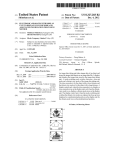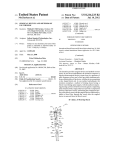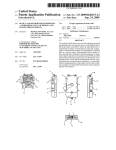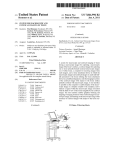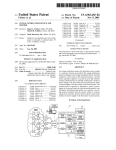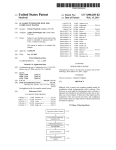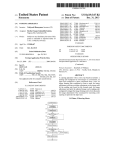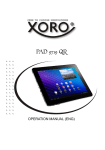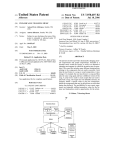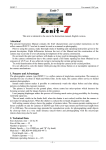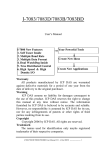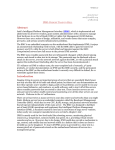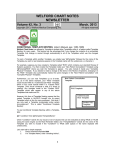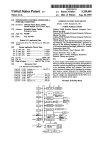Download User definable scanning protocols for use with mammographic
Transcript
US007929740B2 (12) Ulllted States Patent (10) Patent N0.: Marshall et al. (54) US 7,929,740 B2 (45) Date of Patent: USER DEFINABLE SCANNING PROTOCOLS 7,015,808 B1 * 3/2006 Sattler et a1. ................ .. 340/531 FOR USE WITH MAMMOGRAPHIC 7,406,150 B2 * 7/2008 Minyard et a1. . . . . * Inventors: Julian Marshall, Los Altos, CA (US); 1/2003 Stefanescu et a1. 2004/0114714 6/2004 2005/0114039 A1 * 600/407 . . . .. 378/37 Mark B- M” s‘mnyvale’ CA (Us); 58838132383 iii $3882 W115i“ 6‘ a1‘ 233%? Em“ I T‘ Matuska’ Stockton’ CA (Us) 2008/0049996 A1 * 2/2008 Marshall u e . .et . . . a1. . . . . . . . .. 382/128 2008/0069416 A1* 3/2008 Luo .................. .. (73) Asslgneei Hologw, I110, Marlborough, MA (US) (*) Notice: Subject to any disclaimer, the term ofthis 382/131 2009/0003679 A1* 1/2009 382/132 2010/0131873 A1 * 5/2010 Mejia et a1. ................. .. 715/764 WO2004/049908 * 6/2004 * cited by examiner May 15, 2007 _ (65) Ni et al. ....... .. FOREIGN PATENT DOCUMENTS WO (21) Appl. No.: 11/803,558 382/128 2008/0279439 A1 * 11/2008 Minyard et a1. patent is extended or adjusted under 35 USC. 1 5 4 (b) by 977 days‘ Primary Examiner * Sath V Perungavoor _ _ (74) Attorney, Agent, or Firm * Brian J. Daiuto Prior Publlcatlon Data Us 2008/0049996 A1 (63) Minyard et a1. . . . . 702/19 _ Filed: 1.1; ...;;..3;§@; 2003/0013951 A1 * A1* . . . .. 378/37 5/2005 Kennedy et a1. _ (22) . 2001181121 21, 113221 SCANNING SYSTEMS (75) Apr. 19, 2011 Feb. 28, 2008 (57) _ A system and method for processing mammographic data are _ Related U‘s‘ Apphcatlon Data Continuation-in-part of application No, 10/998,121, ?led on Nov. 26, 2004, noW abandoned. ABSTRACT described. The system includes a user input/output system adapted and con?gured to receive from a user a user-de?ned scanning protocol that identi?es the laterality and vieW type for each mammographic ?lm in a ?lm case to be scanned. A (51) Int- ClG06K 9/00 Ulsl (58) storage system stores the user-de?ned scanning protocol for subsequent use in scanning ?lm cases. A scanning system (2006-01) - - - - - - - - - - - - - - - - - - - - - - - - Field Of ClaSSi?CatiOH Search ................. .. 382/128 mammographic ?lm, A processor then assigns laterality and See application ?le for Complete Search history. vieW types to the digitized versions of the mammographic _ References Clted ?lm according to the user-de?ned scanning protocol. The system also receives user alterations to stored scanning pro (56) tocols. The system can also re-assigns a case scanned accord U.S. PATENT DOCUMENTS 5,917,929 A * 6,031,929 A * 6/1999 2/2000 Marshall et a1. . MaitZ et a1. .... .. 6,574,629 6/2003 Cooke et a1. B1 * ing to one scanning protocol to another scanning protocol in .... .. 382/128 .. 382/132 ... .. . . . . . . . . .. 1/1 6,734,880 B2 * 5/2004 Chang et a1. 6,853,857 B2 * 2/2005 Pfeiffer et a1. .... .. 600/436 6,873,717 3/2005 Lure et a1. . . . . .. B2 * 6,915,154 B1* .. 715/738 ........ response to a user’ s instruction to do so. The system processes the digitized versions according to at least one computer aided detection (CAD) algorithm for detecting anatomical abnormalities therein. 382/128 7/2005 Docherty et a1. ........... .. 600/431 17 Claims, 9 Drawing Sheets User selects an existing scanning protocol to use m 1 User loads stack of ?lms of one or more cases into scanner m 1 User loads initiates scanning using selected scanning protocol L7 User manual/y corrects ?lm 91 8 ilms correctly scanned? infon'nalion; or re-assigns case to a different scanning protocol 9g) US. Patent Apr. 19, 2011 Sheet 2 019 US 7,929,740 B2 US. Patent anvit. Apr. 19, 2011 Sheet 7 019 US 7,929,740 B2 US. Patent Apr. 19, 2011 Sheet 8 0f 9 User indicates intention to add a new scanning protocol _7l2_ User de?nes: (a) name for new scanning protocol; and (b) DICOM Study Description Z13 User enters: (a) side; (b) View; (0) modi?ers; and (d) other information for first? lrn Z? User adds new ?lms and associated information as necessary Z1_8_ User rearranges order of ?lms in case as necessary7 .20 User saves new scanning protocol _7__2_2 User selects which protocol will be the default scanning protocol Z22 US 7,929,740 B2 US. Patent Apr. 19, 2011 Sheet 9 019 US 7,929,740 B2 User indicates intention to edit exsisting scanning protocol .612 User modi?es information relating to study 513 User modi?es information for one or more ?lms 814 User adds new ?lms or deletes ?lms from scanning protocol m User selects an existing scanning protocol to use 911 User re-arranges order of films in case as necessary 818 User loads stack of ?lms of one or more cases into User saves modi?ed scanning scanner 916 protocol 53g FIG. 8 User loads initiates scanning using selected scanning protocol _9_1_7 User manually corrects film ilms correctly scanned? information; or re-assigns case to a different scanning protocol QE FIG. 9 US 7,929,740 B2 1 2 USER DEFINABLE SCANNING PROTOCOLS FOR USE WITH MAMMOGRAPHIC COMPUTER-AIDED DETECTION AND FILM SCANNING SYSTEMS Information System) equipment directly to the radiologists’ vieWing Workstations, have not yet become common. According to one estimate, approximately 90 percent of all mammography systems WorldWide are still ?lm-based units, and an equivalent percentage of all mammograms taken yearly are ?lm-based mammograms rather than digital mam CROSS-REFERENCE TO RELATED APPLICATION This patent application is a continuation-in-part of US. Ser. No. 10/998,121, ?led Nov. 26, 2004 noW abandoned, mograms. Because ?lm-based mammograms require digiti Zation prior to performance of CAD algorithms, a substantial number of Work?oW-related issues can arise. 10 One important issue relates to the scanning and identi?ca tion process for ?lm-based mammograms. For a CAD algo rithm to be effective, it is usually desirable for a typical 18x24 published as US 20060126909A1, Which is incorporated by reference herein. cm or 24x30 cm ?lm mammogram to be digitiZed at about 50 FIELD microns of spatial resolution and about 12 bits of dynamic range. Even using today’s scanning technologies, it can take This patent speci?cation relates to processing medical images. More particularly, this patent speci?cation relates to processing ?lm-based medical images for storage, display and/ or computer-aided detection (CAD) applications. a commercial ?lm scanner 15-60 seconds to digitiZe one ?lm at these resolutions, and therefore it can take 1-4 minutes to digitiZe a typical ?lm case having 4 vieWs. A stack of 20 cases can therefore take an hour to run through the digitiZer. At least 20 theoretically, the technologist Who placed the ?lm stack in the scanner should be able to perform other duties While the BACKGROUND digitiZation is taking place. Progress has been made toWard Computer-aided detection (CAD) generally refers to the automation of the ?lm scanning process. One example is W0 02/ 45437 A2, Which is incorporated by reference herein, use of computers to analyZe medical images to detect ana tomical abnormalities therein. Sometimes used interchange 25 ably With the term computer-aided detection are the terms computer-aided diagnosis, computer-assisted diagnosis, or computer-assisted detection. CAD results are mainly used by radiologists and other medical professionals as “secondary reads” or secondary diagnoses tools. When analyZing a medi 30 Which describes automatic ?lm orientation and identi?cation based on lead vieW marker and breast outline segmentation. Another example is Published US Patent Application No. US20060126909A1, Ser. No. 10/998,121, ?led on Nov. 26, 2004, Which describes a graphical status indicator having a plurality of spatially ordered ?lm case icons that graphically cal image, the radiologist usually makes his or her oWn ana communicate a current state of the scanning to a technologist lytical determinations before looking at the CAD results, Who may be performing other duties While the digitization is Which either verify those determinations or trigger further taking place. HoWever, practical problems may still arise inspection of the image. Some CAD implementations have Which may cause the technologist to spend substantial time used CAD results in a “concurrent reading” context in Which the radiologists look at the CAD results at the same time that 35 they look at the images. In order for the scanned images to be correctly identi?ed and properly stored, each image must have information cor In the ?eld of mammo graphy, thousands of mammo graphy rectly associated With it. This information includes the case to CAD systems are noW installed WorldWide, and are used to assist radiologists in the interpretation of millions of mam mograms per year. Mammography CAD systems are described, for example, in US. Pat. No. 5,729,620, US. Pat. No. 5,815,591, and US. Pat. No. 5,917,929, each ofWhich is 40 masses, and architectural distortions. The outputs of CAD systems, generally referred to herein as CAD results, are sets of information su?icient to communicate the locations of anatomical abnormalities, or lesions, in a medical image, and can also include other information such as the type of lesion, degree of suspiciousness, and the like. CAD results are most often communicated in the form of reduced-resolution ver sions of the different mammographic vieWs containing anno Which vieW). Film-based medical image scanning systems a certain number of ?lms and the ?lms are stacked in a particular order. This prede?ned standard scanning protocol 45 This is commonly comprised of four ?lms per study, ordered 50 as folloWs: R MLO, L MLO, R CC and L CC. HoWever, a problem With such conventional approaches arises When the scanning system receives a case that does not have the same number of ?lms, the ?lms are ordered differ 55 tations that identify the location and type of potential abnor either in ?lm format on a light box or in digital form on a softcopy Workstation, and then revieWs the CAD results, usu 60 Work?oW processes associated With mammography, including CAD-related Work?oW processes, implicate sub stantial cost issues in practical clinical environments. “All ently, and/or the vieWs do not correspond to the standard scanning protocol set by the manufacturer. Even When auto matic ?lm orientation and identi?cation is available, the lead markers may be inadequate. For example, the lead marker may be partially out of the frame or may be overlapping With part of the breast tissue or patient label. Further, the lead marker detection systems may especially have trouble cor rectly identifying vieW types that are not one of the four standard screening vieWs. Errors in ?lm identi?cation are costly and time consuming to correct. If the error is noticed by the technologist during the digital” mammography environments, in Which digitally cap tured mammograms could be automatically shepherded, With is de?ned by the manufacturer in advance based on What the manufacturer expects its most likely application to be. In many cases this standard scanning protocol is chosen as the common mammography screening case in the United States. mality. The radiologist analyZes the original mammogram, ally on a display monitor or a paper printout. Which it belongs, as Well as type of image (Which side and have conventionally assumed that each case to be scanned has incorporated by reference herein. Mammography CAD algo rithms analyZe digital or digitiZed images of standard mam mographic vieWs (e.g. CC, MLO) for characteristics com monly associated With breast cancer, such as calci?cations, and attention in the scanning and image identi?cation pro cess. 65 scanning process, the technologist may use a user interface to little or no human intervention, through CAD systems and manually identify each image. If the technologist does not related HIS/RIS (Hospital Information System/Radiology notice the error, the ?lm may be associated With the Wrong US 7,929,740 B2 3 4 case. The radiologist may recognize the error during his or her ning protocol preferably includes the number of ?lms in each revieW, and expend valuable time making a correction. If the technologist or technician responsible for scanning case and the sequence of the ?lms. The system is preferably adapted to receive user alterations to stored scanning proto cols. The system is also preferably adapted to re-assign a case scanned according to one scanning protocol to another scan ning protocol in response to a user’s instruction to do so. The the cases knoWs ahead of time that the case does not conform to the standard scanning protocol, the information may be manually entered. However, this may be unduly time con suming, and in many cases such non-standard cases are sim system is also preferably adapted to process the digitiZed ply not scanned. If the case is not scanned at all, not only does versions according to at least one computer aided detection the case forego the potential bene?ts of CAD processing, the case is also unavailable for analysis and comparison in later therein. (CAD) algorithm for detecting anatomical abnormalities years, at a time When the move to all digital mammography may have taken place at the particular medical facility. BRIEF DESCRIPTION OF THE DRAWINGS It is important to note that there are many Ways in Which the FIG. 1 illustrates a CAD station in a combination ?lm case may not conform to the manufacturer’s standard scan ning protocol. For example, diagnostic mammography cases based and digital mammography environment according to commonly have more than four ?lms and include other types embodiments; of vieWs such as ML, LMO, LM, XCC, XCCL, XCCM, EB and SIO for each breast. Certain types of populations may have different imaging procedures. For example, in some medical imaging facilities, certain ethnic populations may have a different standard screenings. A patient my have only FIG. 2 illustrates a display screen corresponding to the CAD station of FIG. 1 according to embodiments; FIG. 3 illustrates a display screen corresponding to the 20 CAD station of FIG. 1, for creating, editing and removing scanning protocols, according to embodiments; one breast due to a prior mastectomy. Some geographic FIGS. 4a-b illustrate a scanning protocol template screen regions may have different screening protocols. For example for creating and editing scanning protocols, according to embodiments; in the Netherlands, after a standard four-?lm screening, in subsequent years screening mammography cases typically consist only of tWo ?lms: R MLO and L MLO. Some systems alloW the user to specify a different number of ?lms per case. One example is the SecondLook® 700 system from iCAD, Inc., Which alloWs users to specify the number of slides per study. HoWever, if one case in a large stack of cases has a missing ?lm, or and extra ?lm, then all of later scanned cases in the stack can have costly identi?cation 25 scanning protocols, according to embodiments; FIG. 6 illustrates a display screen corresponding to the 30 CAD station of FIG. 1 according to embodiments; FIG. 7 illustrates steps involved in creating a neW scanning protocol, according to embodiments; FIG. 8 illustrates steps involved in editing an existing scan ning protocol, according to embodiments; and errors. Moreover, the user still must go through a time con suming process for each ?lm of each case to identify the laterality, vieW and other critical information if the cases do not match one the standard cases supplied by the manufac FIG. 5 illustrates a display screen corresponding to the CAD station of FIG. 1, for creating, editing and removing FIG. 9 illustrates steps involved in scanning ?lms using a 35 scanning protocol, according to embodiments. DETAILED DESCRIPTION turer. Accordingly, it Would be desirable to provide a system for medical ?lm digitiZation that is easier for a technologist cases that do not correspond to a standard case that has been de?ned FIG. 1 illustrates a CAD station 102 in a combination 40 by the manufacturer, thereby leading to cost savings and increased productivity. to an embodiment, including a ?lm-screen mammogram acquisition device 104 and a digital mammogram acquisition device 106. The digital mammogram acquisition device 106 It Would be further desirable to provide such a digitiZation is coupled to a netWork 108, usually a netWork containing a and/ or processing system in a manner that ?exibly accommo dates cases of different composition, thereby increasing the likelihood that the case is digitiZed and stored, thereby facili tating evolution from ?lm environments to digital environ ?lm-based and digital mammography environment according 45 HIS/RIS (Hospital Information System/Radiology Informa tion System) and a PACS (Picture Archiving and Communi cations System).As used herein, the term “digital case” refers to a group of mammogram images corresponding to a patient ments. SUMMARY 50 graphic imaging process are often termed “clients” rather than “patients” in many clinics to denote that they are not A system, method, and related computer program products are provided for processing ?lm-based mammographic data. The system preferably includes a user input/ output system adapted and con?gured to receive from a user a user-de?ned and acquired from a digital mammogram acquisition device. Although asymptomatic persons undergoing the mammo 55 scanning protocol that identi?es the laterality and vieW type symptomatic, the single term “patient” is used herein for simplicity and clarity of description. The group of digitally acquired mammogram images forming the digital case is usually obtained during the same patient visit. The netWork for each mammographic ?lm in a ?lm case to be scanned. A 108 transfers the digital cases to the CAD station 102 for storage system is in communication With said input/ output CAD processing. Upon successful completion of the CAD system, and is programmed and arranged to store the user de?ned scanning protocol for subsequent use in scanning ?lm cases. A scanning system is preferably adapted to receive and 60 or other medical professional in conjunction With the digi tally-acquired mammogram images. There may be more than one digital mammogram acquisition device, each having a different hardWare address With respect to the netWork 108. scan a plurality of ?lm cases, generating therefrom a digitiZed version of each mammographic ?lm. A processor in commu nication With said storage system and said scanning system is adapted and programmed to assign laterality and vieW types to the digitiZed versions of the mammographic ?lm according to the user-de?ned scanning protocol. The user-de?ned scan processing, CAD results are then transferred over the netWork 108 to a softcopy Workstation 110 for revieW by a radiologist 65 As used herein, the term “?lm case” refers to a group of mammogram images corresponding to a patient, the mam mogram images being acquired using a ?lm-based mammo US 7,929,740 B2 5 6 gram acquisition device. The group of mammogram images forming the ?lm case is usually obtained during the same unit 130 are combined into a single, off-the-shelf personal computer (PC) box having an Intel Pentium IV processor With patient visit. Illustrated in FIG. 1 are ?lm cases 112 that are physically carried over to the CAD station 102 for scanning hyper-threading capability and running the Linux operating system. The user-interface, scanning control, data transfer, and, optionally, CAD processing, and subsequently physi and scheduling functionalities described herein can be pro cally carried over to a ?lm revieW station 114, Which may or grammed in C++ using the GTK toolkit and G++ compiler. may not be con?gured to display CAD results. Upon success ful completion of any CAD processing, CAD results are The data storage unit 130 stores received digital cases and scanned ?lm cases, along With their associated CAD results, transferred over the netWork 108 to the ?lm revieW station 114. In one common scenario, the ?lm revieW station 114 comprises a motorized vieWer upon Which the ?lm cases 112 received and scanned. Cases are queued for CAD processing in the order of priority and, Within a particular priority, in the according to a circular buffer arrangement based on times are loaded and synchroniZed With digital displays 116 that order of time received or scanned. In one embodiment, all ?lm cases are assigned a medium priority, While digital cases shoW reduced-resolution versions of the mammogram images annotated With CAD markers and other information derived from the CAD results. Also shoWn in FIG. 1 is a second CAD station 140 connected to netWork 108. Accord ing to embodiments, CAD stations 102 and 140 can be used are assigned a high, medium, or loW priority according to Which digital mammography acquisition device they origi nated from, this priority level being assigned at the installa tion time of the CAD station 102 or during a maintenance for creation, editing, storage and use of various scanning session thereof. In another embodiment, the CAD station 102 protocols as described in further detail herein. According to an embodiment, scanning protocols can be created and edited may expose more than one port, or expose more than one 20 DICOM Application Entity (AE), to the HIS/RIS netWork, With each port or AE corresponding to a different priority on one CAD station and then transmitted via netWork 108 for storage and use by another CAD station. According to yet level. In this case, each of the digital mammogram acquisition further embodiments, stations 102 and 140 can be ?lm scan Workstations can establish associations With the desired port or AE according to a desired CAD processing priority deter ning systems or ?lm scanning platforms Without CAD capa bility such as DigitalNoWTM systems available from R2 Tech 25 nology, Inc. Thus, according these alternative embodiments, references herein to “CAD station” refer instead to “?lm scanning station” or “?lm scanning platform.” Notably, the environment of FIG. 1 around the CAD station 102 is presented by Way of example only and is not intended 30 to limit the scope of the embodiments to this particular sce nario. By Way of example, many different setups can be used for revieWing ?lm cases and their associated CAD results, such as simple light boxes in conjunction With paper printouts of the CAD results. By Way of further example, different combinations of the devices of FIG. 1 can be placed adja 35 gram case, usually just before the acquisition of the ?lm 45 50 display 122. 55 FIG. 2 illustrates a display screen 202 corresponding to the CAD station of FIG. 1 according to an embodiment. As described more fully in Published US Patent Application No. display 122, Which is preferably a touchscreen display but US20060126909A1, Ser. No. l0/998,l2l, incorporated herein by reference, display screen 202 comprises a graphical 60 selection device. The processor 120 comprises a digitiZeruser interface and control unit 124, a computer-aided detection (CAD) unit 126, a scheduling unit 128, and a data storage unit digitiZer user interface unit 124, the computer-aided detection (CAD) unit 126, the scheduling unit 128, and the data storage scanner reads the barcode of each separator sheet to differen tiate the respective ?lm cases, as Well as to alloW association betWeen that CAD case ID and the rest of the information for that ?lm case. The technologist can preferably simply scan the barcode on the separator sheet using the handheld barcode scanner 132, and the information is instantly displayed on the ?lm cases 112. The ?lm scanner 118 can comprise a laser 130. According to one embodiment, the functionalities of the mammogram, in accordance With Whichever HIS/RIS data base system is used at that clinic. As described in W0 02/ 43457 A2, during scanning of the ?lm stack, the ?lm also be termed a ?lm digitiZer, for scanning and digitiZing the Which can alternatively be implemented on a non-touch screen monitor using an associated mouse or other pointing/ ID, Which is temporarily unique but generally re-usable according to the number of separator sheets in use at the clinic, is associated With a patient ID, case ID, accession number, etc., of a particular patient for a particular mammo environments as Well. scanner such as the Model 2908 Laser Film DigitiZer from Array, Inc. Alternatively, the ?lm scanner 118 can comprise a CCD scanner or other scanner having similar ?lm scanning capabilities as the above laser and/or CCD scanners. The CAD station 102 further comprises a processor 120 and a scanner 132 that facilitates convenient access to any particu lar ?lm case based on the barcode of its case separator sheet. scanner 118, as described in WO 02/43457 A2. The CAD case 40 applicable in ?lm-only environments and/or in digital-only CAD station 102 comprises a ?lm scanner 118, Which can and priority levels can thereby be assigned on a per-case basis. Any of a variety of other prioritiZation schemes are Within the scope of the embodiments. According to embodi ments, data storage unit 130 also stores scanning protocols to be used in scanning ?lm cases and assigning to each scanned ?lm laterality, vieWs and other information as described fur ther herein. CAD station 102 further comprises a handheld barcode In a typical ?lm-based CAD Work?oW, a separator sheet having a CAD case ID is placed on top of the ?rst sheet of each ?lm case in a stack of ?lm cases being fed into the ?lm cently to each other or integrated into the same hardWare boxes Without departing from the scope of the embodiments. By Way of still further example, the netWork 108 can be a Wide-area netWork With the different nodes being distributed throughout a city, a country, or the World. Alternatively, and by Way of still further example, some or all of the transfer of digital information can be achieved by physical transfer of disks, memory sticks, or other digital media devices Without departing from the scope of the embodiments. It is to be appreciated that although FIG. 1 illustrates a combined ?lm/ digital environment, many of the embodiments herein are mined at the digital mammogram acquisition Workstation, status indicator 204 Which comprises a plurality of case icons 206, each case icon corresponding to one of the cases (?lm or digital) received by the CAD station 102. Display 202 further comprises a detail display area 216 Within Which the user can vieW any of the details associated With a studies tab 220, an 65 alerts tab 224, and a controls tab 226. The alerts tab 224 invokes an alert history listing, and the tab itself shoWs a triangular alert icon if there are any alerts present since last US 7,929,740 B2 7 8 being cleared. The controls tab 226 allows access to a variety of maintenance and con?guration screens, and the tab itself scanning protocol by means of Move Up button and Move DoWn button as described beloW. BeloW selection area 234, the case composition 240 is preferably displayed in terms of the laterality and vieWs listed as they are expected to be loaded into the scanner, With the top ?lm listed on the top. FIG. 3 illustrates display screen 202 corresponding to the shoWs a small Wrench icon if there is something requiring maintenance-related attention (e. g., it is time to perform peri odic calibration or other maintenance activity, or a diagnostic error occurred on startup, etc.). According to an embodiment, controls tab 226 is also used to access the facility for creating, CAD station of FIG. 1, for creating, editing and removing scanning protocols, according to embodiments. The user ini tiates the process by touching the controls tab 226. Controls editing and deleting scanning protocols, as described more fully beloW. selection area 302 is shoWn With various control options that The studies tab 220 causes the details of the currently selected case to be displayed, including text details 227, a patient ?ash area 228 containing the ?ash of a scanned ?lm, are touch screen selectable. The user selects the scanning and a thumbnail area 230 shoWing thumbnails of mammo selecting scanning controls 304, the system generates and displays a list of existing scanning protocols in scanning control 304 from the list in controls selection area 302. By graphic vieWs that have been scanned and/ or processed thus far. The display 202 further comprises a search area 232 protocol list area 306. Note that the scanning protocols listed in area 306 preferably corresponds to the list displayed in alloWing searching by any of a variety of criteria (e.g., patient ID, patient name, CAD case ID, accession number, etc.). protocol selection area 234. The user indicates the intention to create a neW scanning protocol by touching neW button 308. Also shoWn in FIG. 3 is Edit button 310, used to indicate the Patient ID area 233 alloWs for the display of the patient ID. A scanning protocol selection area 234 alloWs the user to select betWeen several different scanning protocols. As used herein, 20 user’s intention to edit and existing scanning protocol. the term “scanning protocol” refers to a de?ned composition Remove button 312 is used to indicate the user’s intention to of ?lms in a stack of ?lms loaded in the scanner feeder. The scanner assumes that the ?lms Will be separated in to cases, permanently delete an existing scanning protocol. After each having the composition according to the selected scan ning protocol. As used herein, the term “user” refers to a lead remove button 312 is touched there is preferably a Warning WindoW displayed With text such as “You are about to remove 25 technician, technician or other scanner operator that is gen scanning protocols. The scanning protocol at the top of the list erally employed by or otherWise associated With the medical facility Where the scanning and/ or CAD systems are installed and operated. The term “user” is not intended to refer to employees, contractors or agents of the manufacturer and/or is preferably alWays the default scanning protocol. FIGS. 4a-b illustrate scanning protocol template screen 30 create and/or edit a scanning protocol, scanning protocol According to an embodiment, display screen 202 includes template screen 402 is preferably displayed as shoWn in FIG. 4a. Screen 402 includes scanning protocol name area 404 a number of prede?ned scanning protocols. Scanning proto col selection area 234 is shoWn including six different scan 35 marker and breast outline segmentation is performed (see can preferably use this ?eld to edit the name of an existing WO 02/43457 A2, supra). “Auto” assumes that (1) there are likely to be four ?lms per study, (2) the ?lms are taken using 40 LCC, RMLO and LMLO). The “Any” scanning protocol makes no assumption about What ?lms are in the cases. This scanning protocol requires manual identi?cation of each image after scanning. Other scanning protocols can be pro Which either displays the name of the protocol being edited, or in the case Where a neW protocol is being created, alloWs the entry of the name of the neW scanning protocol. The user matic ?lm orientation and identi?cation based on lead vieW recogniZed lead markers for correct identi?cation, the (3) the cases consist of the four standard screening vieWs (RCC, 402, for creating and editing scanning protocols, according to embodiments. In response to receiving the user’s intention to designers of the scanning and/or CAD systems. ning protocols. The “Auto” scanning protocol provides auto a scanning protocol. Are you sure?” Move Up button 314 and Move DoWn button 316 are used for re-ordering the list of scanning protocol. The name of the scanning protocol in area 404 is preferably identical to the name used in the scanning protocol selection area 234 shoWn and described With respect to FIG. 2. Also provided in screen 402 is a DICOM study description area 430. DICOM study description 430 is used for entry, display and editing of the DICOM study descrip 45 tion, Which is preferably used by Workstations to determine vided as listed in the Table 1, however according to embodi hoW to display (or hang) the digitiZed ?lm images When using ments described herein, the user can edit, delete and create a system such as DigitialNoWTM from R2 Technology, a Hologic® company. For users Who make use of the DICOM neW scanning protocols in order to customiZe and improve the study description ?eld, the DICOM study description and the scanning process. 50 TABLE 1 Scanning Protocol Composition Screening Uni Right RCC, LCC, RMLO, LMLO RCC, RMLO, RXCC Uni Left LCC, LMLO, LXCC Screening Imp scanning protocol name can be the same, or the scanning protocol name can be an abbreviation of the DICOM study description or any other unique string. Film list area 406 is used to display the order of the ?lms that Will be included for each case in the scanning protocol. In the example of FIG. 4a, 55 RCC, LCC, RMLO, LMLO, RCCID, LCCID, RMLOID, LMLOID one ?lm is shoWn that is currently identi?ed as L CC. The user indicates an intention to modify the settings for a ?lm in the case by selecting the ?lm, such as L CC ?lm 408, in ?lm list area 406. NeW button 410 alloWs for the user to add neW ?lms to the protocol for the case. Remove button 412 alloWs for the The user preferably selects the desired scanning protocol 60 selection, the selected scanning protocol is highlighted to indicate Which protocol Will be used for scanning. If no user selection is made, a default scanning protocol is used for the scanning, Which is preferably the ?rst scanning protocol listed in selection area 234. The ?rst scanning protocol listed can be changed by the user in order to change the default user to delete a selected ?lm. The name of the current ?lm is preferably displayed in area 414, Which corresponds to the ?lm selected and preferably highlighted, in area 406. Area using the touch screen on protocol selection area 234. After 65 416 is used to identify the ?lm as left, right or both. Area 418 is used to identify the vieW type of the ?lm. Area 420 is used to add modi?ers to the ?lm, and Area 422 used to indicate When the ?lm is a partial vieW and/or there is an implant present. FIG. 4b illustrates an example With a total of ?ve US 7,929,740 B2 9 10 ?lms added using new button 410 and the identifying ?elds 416, 418, 420 and 422. Film “L M S MLO” 440 is currently highlighted and is shoWn in area 414. Up and doWn buttons saves the neWly created scanning protocol. In the example of FIGS. 4a-b, this is accomplished using OK button 436. 424 and 426 are used to re-arrange the order of the ?lms in the ning protocol, according to embodiments. In step 812, the scanning protocol, and as displayed in ?lm list area 406. If the user is not satis?ed With changes made, the user has the option user indicates an intention to edit and existing scanning pro FIG. 8 illustrates steps involved in editing an existing scan tocol. In the example of FIG. 3, this is accomplished by selecting controls tab 226, scanning control 304, and then edit of cancelling all the current changes by touching the cancel button 3 1 0. In step 813, the user enters information relating to the study to be scanned. In the example of FIGS. 411-!) this is button 432. If the user is satis?ed With the changes made, then the OK button 436 is touched and the edited or neW scanning accomplished by entering the scanning protocol name in area protocol is saved. 404 and study description in area 430. In step 814, the user FIG. 5 illustrates display screen 202 corresponding to the modi?es information for one or more ?lms. In the example of CAD station of FIG. 1, for creating, editing and removing scanning protocols, according to embodiments. In particular, FIGS. 4a-b, this is accomplished by entering or altering the information in ?elds 416, 418, 420 and 422 for each ?lm. In FIG. 5 shoWs a vieW of screen 202 With a neWly added step 816, the user adds neW ?lms or deletes ?lms from the scanning protocol 506 named “Diag L” in scanning protocol scanning protocol. In the example of FIGS. 4a-b, this is list area 306. The neW scanning protocol is also preferably displayed in protocol selection area 234. When a protocol is selected in area 306, the order of ?lms in the case is displayed in area 512. 20 According to an embodiment, the default scanning proto col can be assigned by re-arranging the order of the scanning the top being scanned ?rst. In the example of FIGS. 4a-b, selecting ?lms in area 406 and up and doWn buttons 424 and 426 are used to accomplish this step. In step 820, the user protocol list in area 306 using the move up and move doWn buttons 314 and 316 respectively. For example the neWly created scanning protocol 510 can be assigned as the default 25 force button 602 if provided. Force button 602 is used to override the scanning protocol used to originally scan the case and instead assign another scanning protocol to the case. For example, if the “Auto” scanning protocol Was used for scan ning the case shoWn in FIG. 6, and in fact the case should have the user indicates an intention to scan a neW case or a multiple cases, and selects an existing scanning protocol to use. In the example of FIG. 2, this is accomplished by choosing and 30 or more cases into the scanner. This is preferably accom 35 plished by placing a separator sheet on the top of each case, as more fully described in WO 02/45437A2. The stack of ?lms is positioned in the input tray of the scanner feeder. In step 917, the user initiates scanning using the selected scanning protocol. This is preferably accomplished by the user press 40 ing the start button on display 202. If no scanning protocol Was selected in step 914, then the default scanning protocol Will be used. In step 918, the user monitors the scanning process as described more fully in Published US PatentAppli cation No. US20060126909A1, Ser. No. 10/998,121. If an error is detected in the scanning process, in step 920, the user can manually correct the ?lm information using a screen that selected scanning protocol. This feature advantageously pro vides for quick and e?icient identi?cation of ?lms by avoid ing a manual identi?cation process. FIG. 7 illustrates steps involved in creating a neW scanning selecting a scanning protocol from protocol selection area 234. In step 916, the user loads a stack of ?lms making up one been scanned using the “Diag L” scanning protocol, the user can select “Diag L” from protocol selection area 234, and then touch force button 602. The system Will retroactively assign the selected scanning protocol for the current case, and identify all the ?lms in the case according to the neWly saves the modi?ed scanning protocol. FIG. 9 illustrates steps involved in scanning ?lms using a scanning protocol, according to embodiments. In step 914, by selecting it and repeatedly touching move up button 314 until protocol 510 is at the top of the list. FIG. 6 illustrates a display screen 202 corresponding to the CAD station of FIG. 1 according to an embodiment. The embodiment illustrated in FIG. 6 is similar to the screen shoWn and described With respect to FIG. 2, except that a accomplished using neW and remove buttons 410 and 412 respectively. In step 818, the user re-arranges the order of the ?lms of the case as necessary to correspond to the expected stack order of the ?lms as Will be loaded in the scanner, With 45 is similar to that shoWn in FIGS. 4a-b, or the user can re protocol, according to embodiments. In step 712, the user assign the case to a different scanning protocol, as shoWn and indicates an intention to add a neW scanning protocol. In the described With respect to FIG. 6. In step 922, the scanning process is completed. example of FIG. 3, this is accomplished by selecting controls Whereas many alterations and modi?cations of the present tab 226, scanning control 304, and then neW button 308. In step 714, the user de?nes a name for the neW scanning pro 50 invention Will no doubt become apparent to a person of ordi nary skill in the art after having read the foregoing descrip tion, it is to be understood that the particular embodiments tocol and optionally a DICOM study description. In the example of FIGS. 4a-b, this is accomplished by entering the information in areas 404 and 430. In step 716, the user enters shoWn and described by Way of illustration are in no Way the identi?cation information such as laterality (side), vieW, intended to be considered limiting. It is to be appreciated, for example, that several of the user interface embodiments modi?ers, etc. associated With the ?rst ?lm in the case. In the 55 example of FIGS. 4a-b, this is accomplished by entering the described supra are applicable in a digital-only mammo information in ?elds 416, 418, 420 and 422. In step 718, neW graphic environment Where easy monitoring and control or ?lms are added as necessary and the identi?cation informa the digital case receiving, processing, and dispensing is tion is added for each neW ?lm. In the example of FIGS. 4a-b. This is accomplished by selecting neW button 410, and then entering information in ?elds 416, 418, 420 and 422 for each 60 neW ?lm. In step 720, the user re-arranges the order of the ?lms of the case as necessary to correspond to the expected stack order of the ?lms as Will be loaded in the scanner, With the top being scanned ?rst. In the example of FIGS. 4a-b, selecting ?lms in area 406 and up and doWn buttons 424 and 426 are used to accomplish this step. In step 722, the user desired. The graphical status indicator can be horizontally oriented, diagonally oriented, etc ., Without departing from the scope of the embodiments. Further types of temporal changes in icon appearance other than blinking, such as rotating icons, can be used as visual textures or cues Without departing from 65 the scope of the embodiments. Even further, although par ticular reference is made to digital x-ray mammography, the scope of the embodiments includes any of a variety of medi cal imaging modalities that, either presently or prospectively, US 7,929,740 B2 11 12 are amenable to CAD analysis and/or softcopy display. 8. A system according to claim 1 Wherein said user input/ output system and said storage system are located in different Present or prospective examples including computerized tomography (CT) imaging, magnetic resonance imaging (MRI), positron emission tomography (PET), single-photon facilities and said communication is made via a Wide-area netWork. 9. A system according to claim 1 Wherein said processor is emission computed tomography (SPECT), and ultrasound, as further adapted to process the digitiZed versions according to at least one computer aided detection (CAD) algorithm for detecting anatomical abnormalities therein. 10. A method for processing ?lm-based mammographic Well as less conventional medical imaging modalities such as therrnography, electrical conductivity-based modalities, etc. Therefore, reference to the details of the embodiments are not intended to limit their scope, Which is limited only by the data, comprising the steps of: scope of the claims set forth beloW. receiving from a user a user-de?ned scanning protocol identifying at least a vieW type for one or more mammo What is claimed is: graphic ?lms in a ?lm case to be scanned using the 1. A system for processing ?lm-based mammographic user-de?ned scanning protocol; data, comprising: storing the user-de?ned scanning protocol in a storage a user input/output system adapted and con?gured to system; receive from a user a user-de?ned scanning protocol scanning a ?lm case comprising plurality of mammo graphic ?lms and generating therefrom a digitiZed ver identifying at least a vieW type for one or more mammo sion of each mammographic ?lm; and graphic ?lms in a ?lm case to be scanned using the user-de?ned scanning protocol; 20 the mammographic ?lms according to the user-de?ned a storage system in communication With said input/ output system, programmed and arranged to store the user de?ned scanning protocol for subsequent use in scan ning ?lm cases; a scanning system adapted to receive and scan a plurality of ?lm cases, generating therefrom a digitiZed version of scanning protocol; Wherein said storage system stores a plurality of scanning protocols, and Wherein said method further comprises 25 receiving a user’ s instruction to re-assign a case scanned according to a ?rst scanning protocol to a second scan ning protocol, Wherein said step of assigning automati cally assigns the vieW type to each digitiZed version each mammographic ?lm; and a processor in communication With said storage system and said scanning system, adapted and programmed to assign vieW types to one or more digitiZed versions of assigning vieW types to one or more digitiZed versions of according to the second scanning protocol in response to 30 the mammographic ?lm according to the user-de?ned scanning protocol; the user’s instruction. 11. A method according to claim 10, Wherein the user de?ned scanning protocol further identi?es the number of Wherein said storage system stores a plurality of scanning protocols and said user input/output system is further adapted ?lms, the sequence of ?lms and the laterality of each mam mographic ?lm in the ?lm case to be scanned using the to receive a user’s instruction to re-assign a case scanned 35 user-de?ned scanning protocol, and said step of assigning according to a ?rst scanning protocol to a second scanning further comprises assigning a laterality to each digitiZed ver sion of the mammographic ?lms according to the user-de protocol, said processor further adapted to automatically assign the vieW type to each digitiZed version according to the second scanning protocol in response to the user’s instruc tion. 2. A system according to claim 1, Wherein the user-de?ned ?ned scanning protocol. 12.A method according to claim 10, further comprising the 40 scanning protocols stored in said storage system. scanning protocol further identi?es the laterality of each mammographic ?lm in the ?lm case to be scanned using the user-de?ned scanning protocol, and said processor is further adapted to assign laterality to each digitiZed version of the mammographic ?lms according to the user-de?ned scanning step of receiving from the user alterations to one or more 45 13. A method according to claim 10, said method further comprising the step of receiving from the user a user’s selec tion of Which scanning protocol to use for scanning one or more ?lm cases, and Wherein said step of assigning uses the user’ s selection if available and a default scanning protocol if protocol. no user’s selection is available. 3. A system according to claim 1, Wherein the user-de?ned scanning protocol further de?nes the number of ?lms and the 14. A method according to claim 10 further comprising the step of processing the digitiZed versions according to at least one computer aided detection (CAD) algorithm for detecting sequence of ?lms for each case to be scanned using the 50 user-de?ned scanning protocol. 4. A system according to claim 1, Wherein said user input/ output system is further adapted and con?gured to receive a user-de?ned name for the user-de?ned scanning protocol. 5. A system according to claim 1, Wherein said user input/ output system is further adapted to receive alterations to one or more scanning protocols stored in said storage system. 6. A system according to claim 1, Wherein said storage system stores a plurality of scanning protocols and said user input/output system is further adapted to receive a user’s selection of Which scanning protocol to use for scanning one anatomical abnormalities therein. 15. A method for processing ?lm-based mammographic data, comprising the steps of: scanning a plurality of mammographic ?lm cases, each 55 erating therefrom a digitiZed version of each mammo graphic ?lm; and 60 default scanning protocol in cases Where there is no user selection received. assigning laterality and vieW types to each digitiZed ver sion of the mammographic ?lms according to a stored user-de?ned scanning protocol, the user-de?ned scan ning protocol having been received from a user and identifying a laterality and a vieW type for each mam mographic ?lm in each ?lm case Wherein a storage system stores a plurality of scanning or more ?lm cases. 7. A system according to claim 6 Wherein said user input/ output system is further adapted to receive a user’s selection of Which of the plurality of scanning protocols is be used as a comprising plurality of mammographic ?lms, and gen 65 protocols, the method further comprising receiving a user’s instruction to re-assign a case scanned according to a ?rst scanning protocol to a second scanning proto US 7,929,740 B2 13 14 col, wherein said step of assigning automatically assigns of assigning uses the user’s selection of scanning protocol if the laterality and VieW type to each digitized Version according to the second scanning protocol in response to available and a default scanning protocol if no user’s selec tion is available. the user’s instruction. 16. A method according to claim 15, said plurality of scan ning protocols comprising one or more user-de?ned scanning protocols and one or more manufacturer-de?ned scanning protocols, the method further comprising the step of receiving from the user a user’ s selection of Which stored scanning protocol to use for said step of scanning, and Wherein said step 17. A method according to claim 15, further comprising the step of processing the digitiZed Versions according to at least one computer aided detection (CAD) algorithm for detecting anatomical abnormalities therein.

















